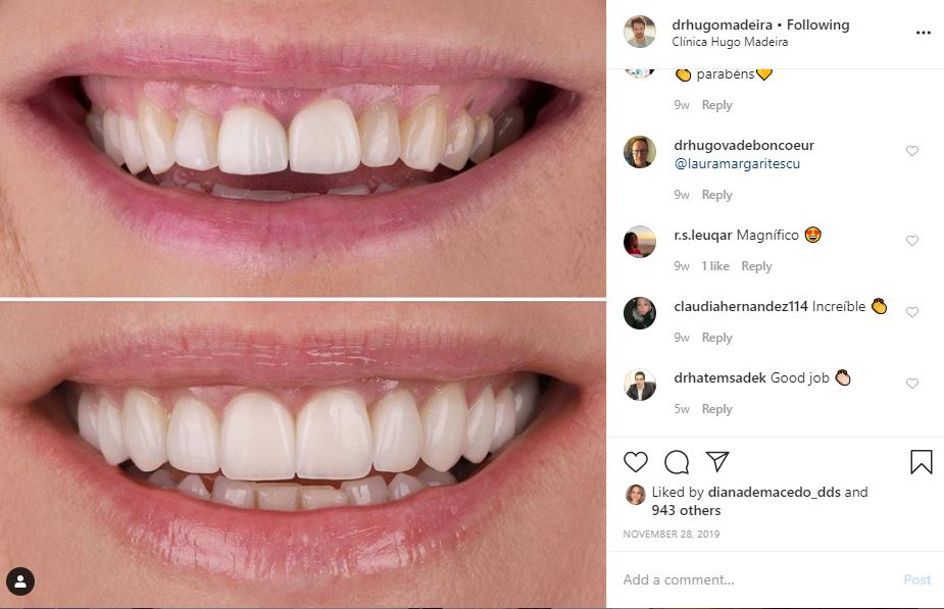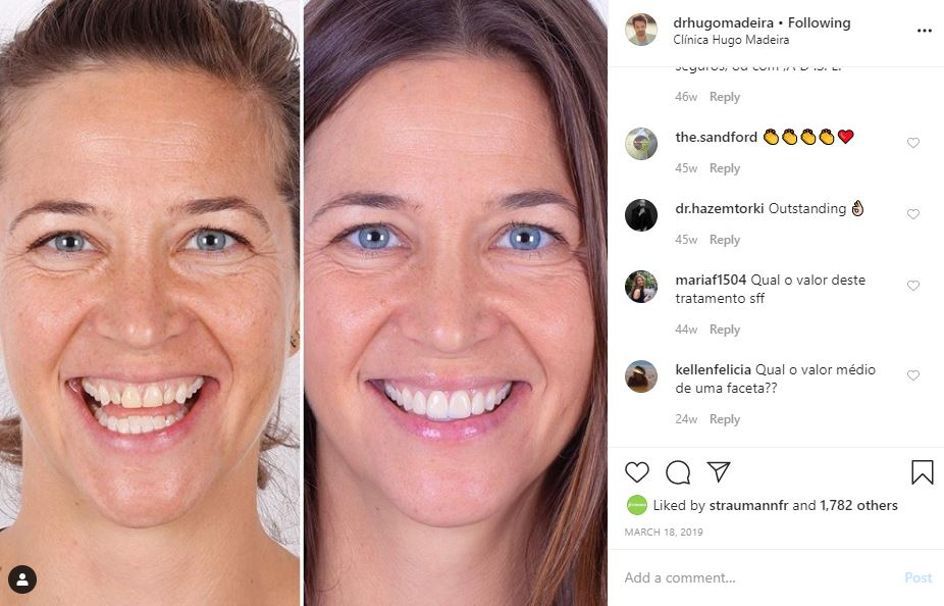Trend 1: Beautiful teeth are viewed as a status symbol
Between 1990 and 2016, the expenditures for dental care in the US have doubled.1 Beautiful teeth and a fantastic smile symbolize the whole state of care of a person and increase their perceived attractiveness. Of course, fashion, hairstyle and flawless skin are still valued beauty markers, but a radiantly beautiful set of teeth – “the intricate balance of mouth angle, smile extent, and dental show” – has probably become one of the most sought-after status symbols.2 Before and after comparisons on social media illustrate what is feasible today and how significantly it affects the appearance.

With courtesy of www.instagram.com/drhugomadeira
Trend 2: Social media driving unrealistic “smile” expectations
With beautiful teeth becoming a dominate beauty marker, it’s not surprising that social media and SMART phones are the top drivers influencing the trend. Images on social media affect the self-perception of many people considerably as many of us can’t help but to compare ourselves to the photos of our friends, celebrities and online role models – even if we know the images are “touched up”. The need to match or be like them has many looking for unrealistic expectations in their dental work, as seen in this article, “Photoshop esthetics”, that have to be scaled down again by the dentist.
“There is a big demand from the patients for highly esthetic solutions.”3 Dr. Gabor Tepper (Esthetic Days 2019 in Baden-Baden)
Trend 3: Orthodontic treatment is becoming a norm
With the advancement of clear aligners as a true option to braces, patients are becoming more open to orthodontic treatments. The treatments are also becoming more affordable and with a smartphone-supported treatment follow-up, orthodontic correction could become a matter of course for people of all ages. However, with all the new technologies, treatment supervision by an experienced orthodontist remains crucial. Walk-in-walk-out orthodontic centres naturally do not offer this and dentists should sharpen patients' awareness of it.
“We have to offer our patients these therapies as well - but with a well-founded basis.” Dr. Kay Vietor (Esthetic Days 2019 in Baden-Baden, Germany)
Dr. Sam Daher on aligner therapy (IDS 2019 in Cologne, Germany)

With courtesy of www.instagram.com/drhugomadeira
Trend 4: Rise of esthetic dentistry as part of self-improvement plans
With increased knowledge in esthetic dentistry, commercials promoting whitening and the increased importance of the perfect smile, more and more patients are willing to include teeth whitening, orthodontics, veneers and other esthetic dentistry treatments as part of their personal self-improvement plans. In the past, visiting the dentist was something the general public did yearly for a teeth cleaning – and getting orthodontics was something that happened only when you were young if your parents could afford it. Now, with the introduction of new types of orthodontics and other teeth correcting procedures, along with the knowledge that their smile could last forever, patients of all ages are willing to budget in esthetic dental treatments just as they would other elective surgeries. In addition, some employment insurance programs are enabling patients to set assign money for elective surgeries such as dental implants and many dentists are offering payment plans to help offset the expense. By educating your patients on clinically relevant treatments that will enable them to have healthy, beautiful teeth and gums and offering payment options, dentists can meet the needs of these patients looking to be their best selves.
Trend 5: 70 is the new 50 – or even 40!
Studies show that well trained 70-year-olds can compete with untrained 40-year-olds. Obviously, many “baby boomers” still feel young these days, and that's how they want to look and be perceived. Teeth that show signs of "wear and tear" due to age or even fall out are no longer a fate for present-day seniors. With a long life expectancy ahead and the pressure to look as good as they feel, even expensive dental treatments are perceived as cost-efficient in the long-term and become key for a high quality of life.
Trend 6: Increased demand for immediate treatment
We live in the age of instant gratification – and this also applies to dentistry. Patients want picture perfect teeth and they want them NOW. As a dentist, they expect you to provide these options. Implants specifically designed for immediacy have been around for some time, but were only suitable for a limited range of indications and were technically very demanding handling. Now with new implant generations – such as the Straumann® BLX Implant System – you can offer a broader range of clinical options together with confidence even in challenging indications.
Prof. Stephen Chen on the rise of immediacy (Buser Symposium 2019 in Bern, Switzerland)
“As a dentist, we are responsible to take control and to become an adviser of the patient.” Dr. Kris Chmielewski (Esthetic Days 2019 in Baden-Baden, Germany)
Trend 7: AI and digital dentistry expected as part of the consultation
With new digital technology that can show you which glasses, which outfit or even which nose will look best, patients are used to seeing what they are purchasing virtually. The same goes with aesthetic dentistry. They want to see how their smile will look before they commit to a procedure and digital imaging allows for a much more realistic representation of the actual situation than in the past. Nowadays, artificial intelligence supported tools can support in the visualization of the desired esthetic outcome already before the first treatment steps, and this can lead to a higher acceptance of the cost estimate.
Trend 8: Increasing demand for natural white ceramic materials
While the use of ceramics in prosthetics has been a common option for some time now, a “breakthrough” is now also on the horizon for metal-free dental implants. While until recently ceramic implants were limited in indication and inferior to titanium implants in handling, products such as the Straumann® PURE Implant System open up completely new possibilities. Especially people with a natural lifestyle show a higher acceptance rate for “natural white” ceramic implants than for conventional ones.4
Seven top experts on the question “The future of implantology: is ceramic the new titanium?”, Esthetic days 2019 in Baden-Baden, Germany
“We can see quite clearly that we have less plaque on ceramic and that we simply have better soft tissue results.” Dr. Julia Wittneben (Esthetic Days 2019 in Baden-Baden, Germany)
Trend 9: Esthetic dentistry no longer considered “cosmetic” only
There was a time when doctors who were exclusively concerned with "beauty" were suspiciously eyed and when only the rich and famous had esthetic dentistry treatment. Nowadays there is no longer such a sharp dividing line between beauty and health, so every dental practice should offer its patients more than just bleaching. Well-judged esthetic treatments are a benefit also for the overall health of a person. Therefore, esthetic dentistry starts to lose its “stigma” as being cosmetic only. It’s now an interdisciplinary activity of dental medicine.
Trend 10: Science is catching up in esthetic dentistry
Corresponding to the demand on patient side, esthetic dentistry is developing very fast and it may be difficult for dentists to stay up to date. Nevertheless, more and more robust data is available, and showing patients the responsible and scientific side of esthetic dentistry can be a significant success factor in patient communication.
straumann.com: Science – more than evidence. A commitment to science.
“There is a solid body of evidence we can rely on.” Vincent Fehmer (Esthetic Days 2019 in Baden-Baden, Germany)
To sum up, the strong and continuous growth of Esthetic Dentistry as a mega trend in dentistry can be attributed essentially to two main factors: the steady improvement in average dental health in many countries, which has reduced the prevalence of previously existing basic functional deficits. Secondly, the increasing desire of many people for self-optimization, which naturally includes a natural awareness of the esthetics of the oral situation. Though dentistry can be expected to remain a truly medical discipline and is not meant to become an "oral beauty industry", one should be prepared for the fact that in the future dentists will "repair" less, but increasingly provide treatments to "upgrade and hone".5
We asked seven top experts in the field what they see as the “hottest” and most pressing questions in the near future in the field of esthetic dentistry: